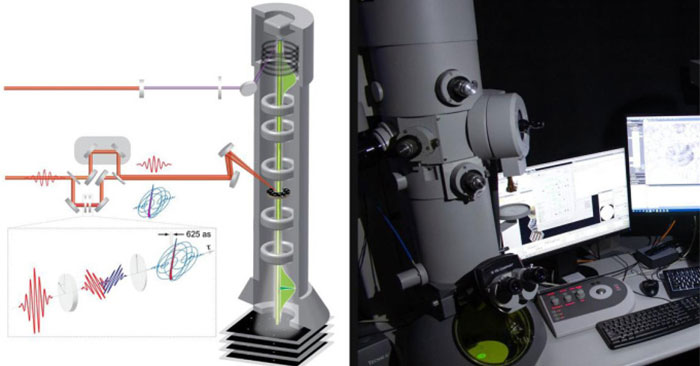Captured electrons moving at 7,920,000 km/h
The new device can capture images of moving electrons by firing electron pulses that last a trillionth of a second. Electrons travel at an incredibly fast speed, about 2,200 km/s or 7,920,000 km/h, and can circle the Earth in just 18.4 seconds.
The team hopes the microscope will lead to new discoveries about how tiny electrons move.

This transmission electron microscope is like a very powerful camera in the latest version of a smartphone, allowing us to take pictures of things we couldn't see before, like electrons, said the study's lead author, Mohammed Hassan, an associate professor of physics and optics at the University of Arizona.
The fact that electrons move so fast has been a major challenge for experts. In the early 2000s, physicists developed a method for generating attosecond (or billionths of a billionth of a second) pulses to create exposure times that could capture the motion of electrons. This research led to the 2023 Nobel Prize in Physics for Pierre Agostini, Ferenc Krausz, and Anne L'Huilliere.
Physicists have reduced microscope exposure times to the scale of a few attoseconds. In doing so, they have deciphered how electrons carry electrical charges, how they behave inside semiconductors and liquid water, and how chemical bonds between atoms are broken. But attoseconds are still too large to capture the individual motions of electrons.
In the new study, the electron gun was modified to produce pulses of just one attosecond. These pulses hit the sample, slowing the electrons as they pass through and changing the shape of the electron beam wavefront. A lens amplifies the slowed-down electron beam, which then hits a fluorescent material. When the electrons hit the material, it glows.
Hassan said the attosecond time resolution of his transmission electron microscope, called 'atto microscopy', allowed scientists to see parts of electrons in motion for the first time. The researchers believe this success will lead to breakthrough advances in physics, chemistry, bioengineering, materials science and many other fields.
You should read it
- The stunning beauty of the small world under the microscope through Nikon Small World Photomicrography winning photos 2018
- 17 stunning photographs taken under a microscope reveal a whole new world
- The world's fastest camera captures at 1 trillion frames per second
- This is the fastest dog in the world, only to lose the grouse
- IBM engineers make microscopes made of Lego, Arduino and Raspberry Pi, for only $ 300
- Top 10 fastest running dogs in the world
 Is it good to eat guava, including the skin?
Is it good to eat guava, including the skin? The world's 'stupid' bird, at the moment of life and death it 'loses its memory'
The world's 'stupid' bird, at the moment of life and death it 'loses its memory' 10 strangest military vehicles in world history
10 strangest military vehicles in world history What happens when lightning strikes a lake?
What happens when lightning strikes a lake? Fabric that cools the body up to 8 degrees Celsius
Fabric that cools the body up to 8 degrees Celsius The killer bird blinds and defeats poisonous African snakes
The killer bird blinds and defeats poisonous African snakes